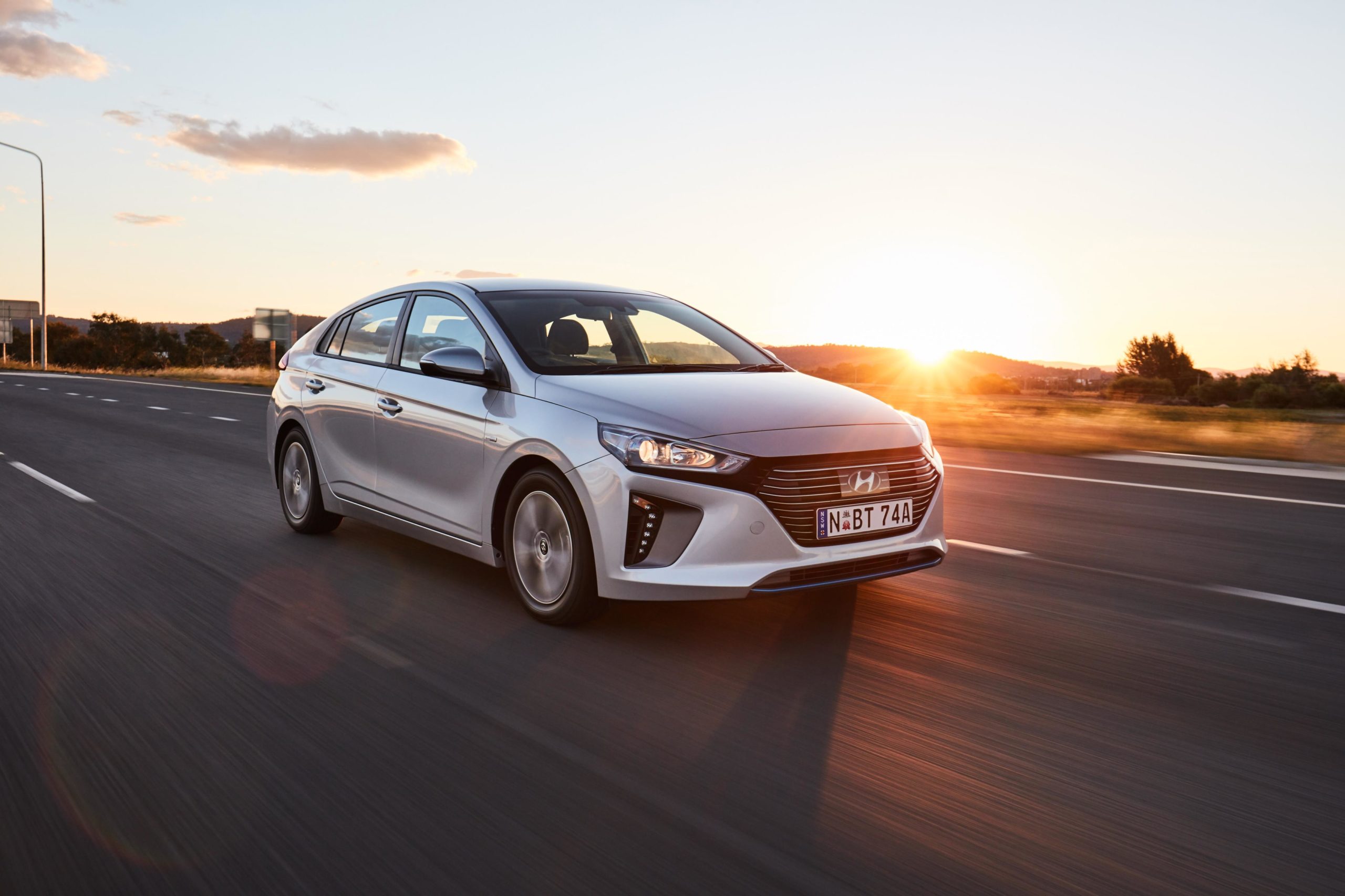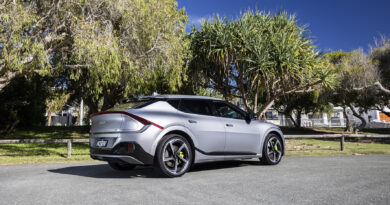Hyundai Ioniq Plug-In Hybrid review
Some people go straight to the 10 metre diving platform and just jump straight in the deep end. Others prefer to work their way up to the big commitment. One metre board first, then three, then … gulp.
The Hyundai Ioniq range is a bit like that. You can dive off the deep end with the battery electric model, stick a toe in the water with the Hybrid, or take the middle option with the Plug-in.
It’s that latter we’re driving here.
Value
Like the other Hyundai Ioniqs there are two different specification levels for the Plug-In. The range starts with the $40,990 Elite and then progresses to the $45,490 Premium. Those prices are plus on-road costs.
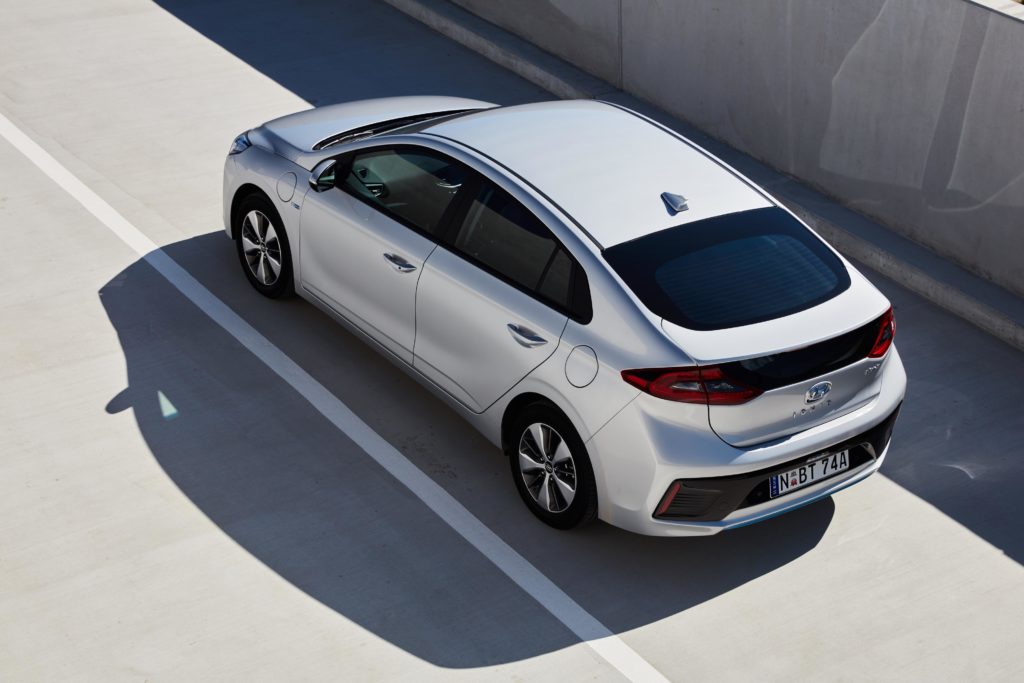
That’s roughly middle ground between the hybrid and the electric versions of the Ioniq. It’s also very competitive against the famous Toyota Prius, which is a hybrid without plug-in capability. It also undercuts the Mitsubishi Outlander PHEV (plug-in hybrid electric vehicle).
Elite standard equipment includes an eight-speaker audio system, sat-nav, Apple and Android smartphone capability, digital radio, dual-zone climate control, a smart key and 16-inch alloy wheels.
The Premium alone has one-touch power front windows, a powered sunroof, leather appointed seats, ventilated and heated front seats, a powered driver’s seat, paddle shifters, wireless charging and rain sensing.
The Ioniq Plug-in comes with a five-year/unlimited-kilometre warranty, an eight-year/160,000km battery warranty and capped-price servicing
Service intervals are 12 months/15,000km for all Ioniqs. The Plug-in costs $265 per service out to 60 months, except in year four when it is $465.
Inside
There’s nothing in the interior that’s going to seem at all spaceship about the Ioniq Plug-in. In fact the foot-operated park brake is a throwback to yesteryear!
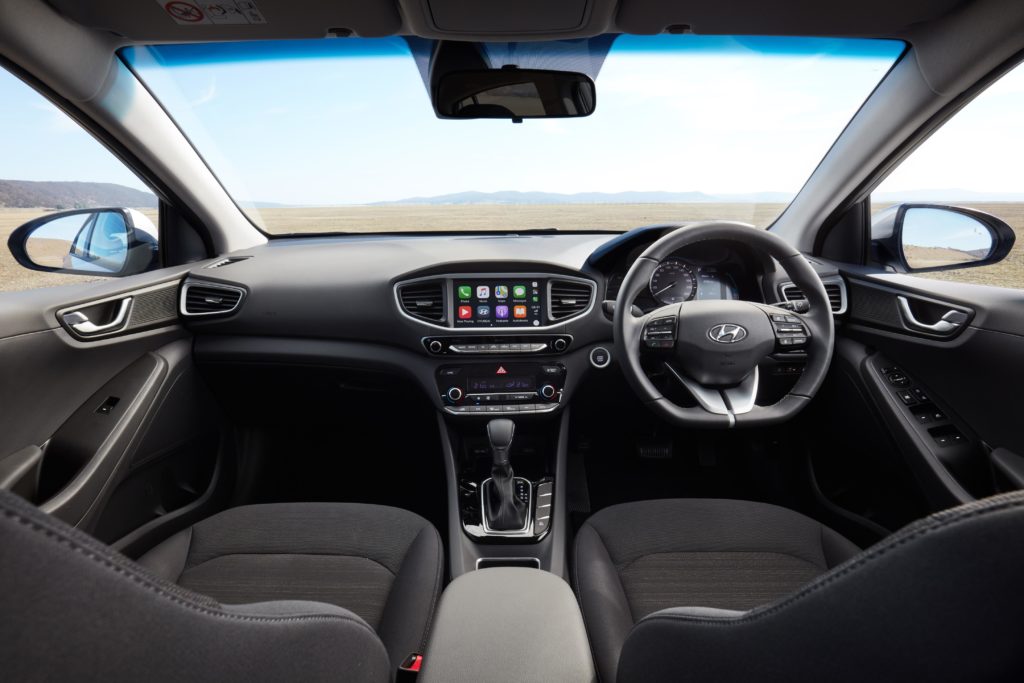
The plastics are predominantly hard to touch and trims uninspiring, even if some are commendably made from recycled sugar cane. The steering wheel is manually reach and rake adjustable, but it does have a sporty flat-bottom. Instrumentation is thoroughly orthodox and an eight-inch touchscreen sits atop the dashboard.
The Ioniq’s swoopy shape cheats the wind but also robs the rear passengers of headroom. Knee room isn’t sensational for adults back there either. They do get air-con vents, but miss out on temperature or fan speed adjustment.

Storage is okay in-cabin. The lidded centre bin is sizable but the door pockets are small, while the boot’s 341 litre capacity is about the same as similar-sized hatchbacks like the Mazda3. But the battery pack under the floor ensures there’s no room for a spare tyre.
Performance and efficiency
The Ioniq Plug-in is powered by a 77kW/147Nm 1.6-litre Atkinson cycle direct injection petrol engine mated to a six-speed dual clutch transmission.
It works in tandem with a 44.5kW/170Nm permanent-magnet synchronous electric motor that is fed by an 8.9kWh lithium-ion polymer battery.
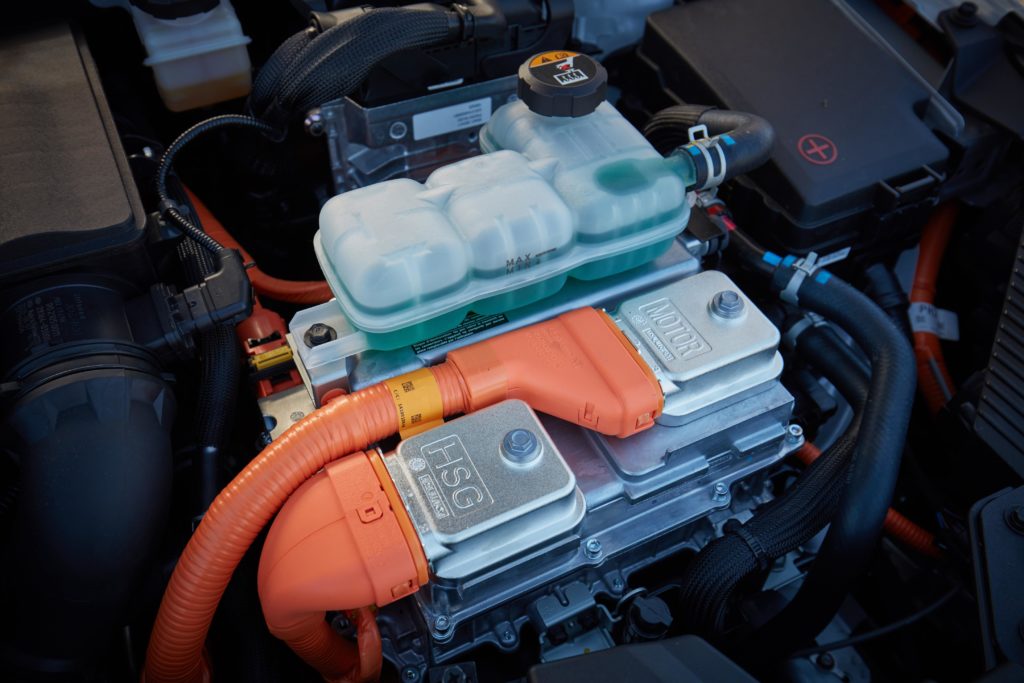
The combined system output is 104kW and 265Nm. By comparison an orthodox 2.0-litre Mazda3 small car makes 114kW and 200Nm from its naturally-aspirated 2.0-litre petrol engine.
Hyundai claims a 63km real-world electric range for the Ioniq plug-in, which is pretty good for this sort of vehicle. We found the reality to be more like 40-45km, which is still thoroughly useful for everyday trips.
It’s enough to handle the average commute electrically, although the car will fire up the petrol engine to look after chores such as heating or when hard acceleration is needed.
There’s no doubt the electric motor helps provide solid acceleration with its happy ability to deliver max torque at zero revs. You certainly miss it when the battery’s flat!
Charging
Plug-in hybrids make some pretty outlandish fuel consumption claims and the Ioniq is no different (blame it largely on the government’s laboratory fuel test). Its official rate is just 1.1L/100km, but unless you can drive just about everywhere electrically that’s unachievable.
Default at start-up is electric drive when the battery is charged. But the driver can manipulate which parts of the powertrain are working when via the EV/HEV button. EV (electric vehicle) for the city and HEV (hybrid electric vehicle) for the freeway works best.
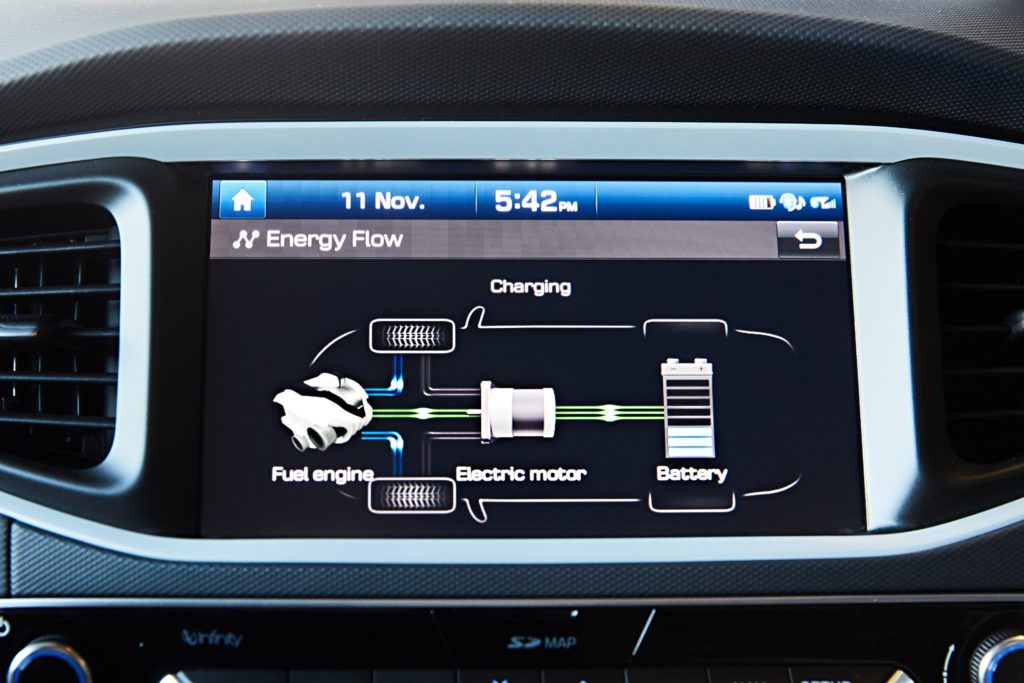
A regenerative braking system allows excess kinetic energy to be captured to charge the battery during driving.
Once the battery is depleted– or when Sport drive mode is selected via the gear lever or shift paddles – the Ioniq Plug-in will continue onward but rely purely on its petrol engine.
AC charging is limited to 3.3kW, which is the equivalent of a 15A powerpoint. It can recharge the Plug-in’s high-voltage battery in two hours 15 minutes when connected to a charging station of equal or higher capacity (the regular powerpoint charger doesn’t have a longer earth pin so is limited to 10A charging if you choose that option). The ability to reach a full charge quickly allows owners to utilise EV mode daily.
The Ioniq Plug-in cannot recharge via DC fast chargers.
The driver is kept apprised of battery performance via a screen displaying charge, range by fuel type and expected charging time. There’s also a graphical representations of vehicle range on the navigation screen, and charging station locations. Users can schedule charging from this screen, to capitalise on off-peak electricity rates where applicable.
Ride and handling
Rolling on locally-tuned MacPherson strut front suspension and an independent rear-end, the Ioniq Plug-in is a neat and tidy drive with good body control and reliable handling. The letdown is the remote and lifeless electric-assist steering.
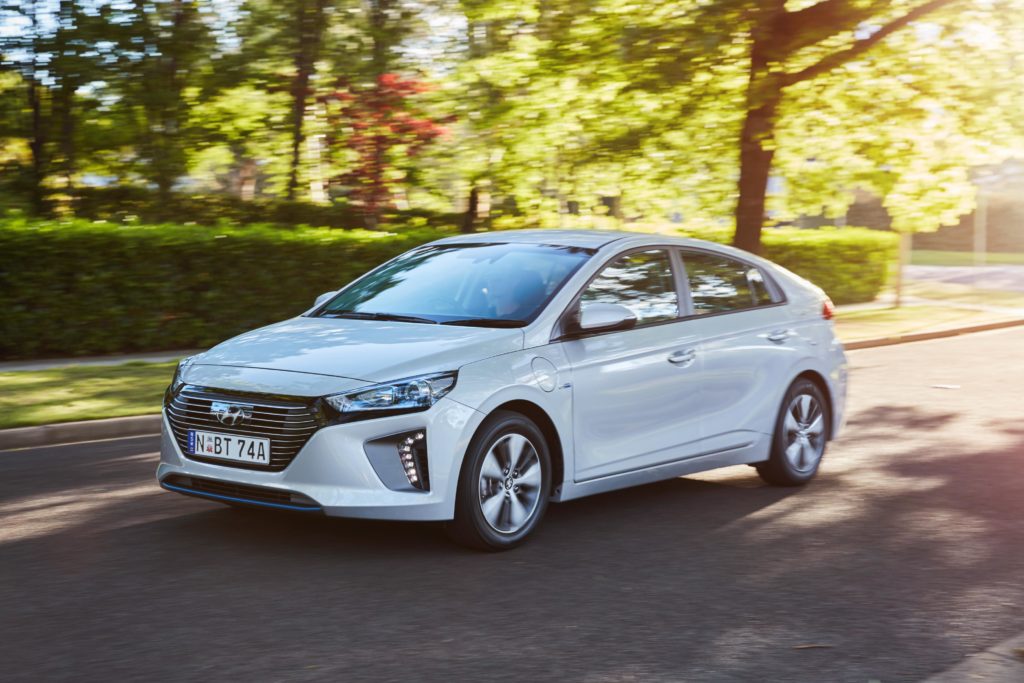
When it’s in electric mode the Ioniq is a quiet drive, although tyre and wind roar fills in for some of the absent engine noise. But once the engine rejoins the fray it’s noticeably louder. It’s not unpleasant, just less pleasant.
One thing we disliked was the hesitant change from first to second in the DCT (dual-clutch transmission) gearbox. One-off or across the range? We’ll have to drive more Ioniq Plug-ins and report back.
Party tricks
The petrol engine’s Atkinson cycle maximises efficiency by delaying the closing of the intake valves. This effectively shortens the compression stroke, while leaving the expansion stroke unchanged, reducing pumping losses and improving the thermal efficiency to an impressive 40 per cent.
All Ioniqs come with Hyundai Auto Link which sends vehicle data such as tyre pressure monitoring, driving history and parking management to a connected smartphone. It even allows driving efficiency comparisons between Ioniq owners. Auto Link Premium adds remote start and access to doors, climate control and defroster.
Safety
Standard Ioniq safety equipment includes seven airbags, a suite of driver assist systems including blind spot detection, lane keep assist and rear cross traffic alert as well as AEB and a reversing camera. Ioniq Premium adds front park assist and LED low beam headlights.
If the vehicle in front stops, the Plug-in’s adaptive cruise control system will slow to 10km/h and then prompt the driver to take over.
The Ioniq comes with a five-star ANCAP safety rating from 2016. The link to the detailed crash report is here.
Verdict
The Ioniq Plug-in is a decent vehicle and it’s easy to see why some people would prefer it over the electric Ioniq and its 280km range. With its 43 litre fuel tank the Plug-in has the ability to travel 500-600km between refuelling.
It’s also cheaper than the Ioniq Electric and that’s another very important consideration.
Don’t forget, if you manage your battery properly you could spend almost as much time travelling emissions free in the Plug-in as the Electric.
Whichever way you go, the good thing is you’re still diving in.
HYUNDAI IONIQ PLUG-IN HYBRID SPECIFICATIONS
Price: $45,490 (plus on-road and dealer costs)
Warranty: 5 years, unlimited km
Battery warranty: 8 years, 160,000km (70% performance guarantee)
EV type: PHEV
Engine: 1.6-litre 4-cylinder
Motor/s: 44.5kW/265Nm permanent magnet synchronous electric motor
Power/torque: 104kW/265Nm
Transmission: 6-speed dual-clutch automatic, front-wheel drive
Fuel use: 1.1L/100km
Electricity use: 9.4kWh/100km (Greenvehicleguide)
Charger types: Type 2
Battery capacity: 8.9kWh
Claimed range:
Maximum charging power AC/DC: 3.3kW/NA
0-100km/h: NA
Top speed: NA

